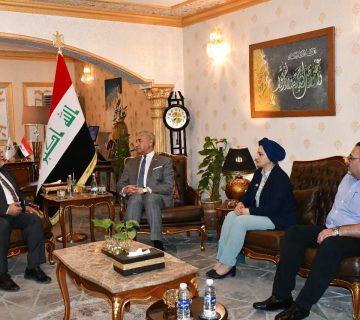Issuing a book on the aesthetics of form in contemporary theater by the college of fine arts
A book was recently issued by the college of fine arts at the university of Baghdad on (the aesthetics of form in contemporary theater) by prof. Dr. Qasem Munis Aziz, dean of the college and instructor in the department of performing arts. This book was issued by (Dar al-Dhifaf), in five chapters dealing with theater according to new artistic concepts depending on demolition, construction and renovation between form and its beauty on one hand and between word and image on the other hand, the latter is considered as a detailed item in this book, relying on the openness of the aesthetic philosophical thought that shed light on the exterior form by the technical staffing of fantasy as a unit and as a linguistic system through movement, gesture, shadow and light inside the moving form that formed in contemporary theater the death and life of scenes at the level of the dialogue as a visual language to communicate meaning on the theatrical show. The author emphasizes in his book that the artistic cultural output is different by providing comprehensive criticism and that we can establish a new theater unless it is based on its old cultural and artistic levels provided dealing with the foundations of problems since they are related to aesthetic thought of theater, its morals and daily life, and since that theater can’t be built abstractly, but experimentally by exercise and daily suffering. In the first chapter, the author explains how modern aesthetic trend has emerged in terms of influence and communication in visual communication aesthetics by discussing visions and philosophical arguments of many philosophers. Chapter II dealt with hypothetical theater, its new magical world so that the actor can transit from acting to personification. Chapter III is entitled (organization and its relation with visual form in theatrical show) in which the author explains light, use of optical mark, the relationship of color and lighting, as well as dealing with light according to harmony, contrast, balance and the relationship of each of these elements with form. Chapter IV is entitled (configuration and optical image language) dealing with formative space, image structure, as well as for technique, employment mechanism where the author explains in detail the types of spaces in theater, while chapter v included selected theatrical models.


